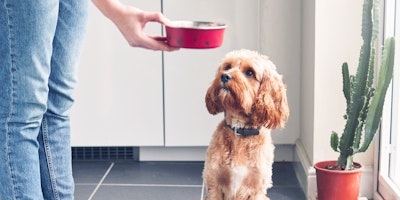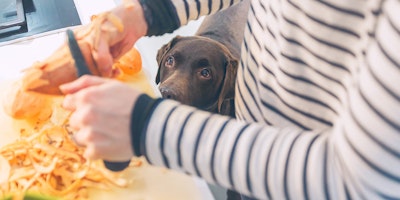
There are a lot of foods dogs should not eat including grapes/raisins, chocolate, walnuts, onions, garlic among many others. Dogs are curious by nature, and most are eager to try people food or just about anything that smells like it might be a tasty treat.
As a result, pet owners need to be cautious and remember many foods which are safe for humans can be toxic for dogs and, in some cases, can even be life-threatening. So, when it comes to food, what can dogs not eat?
Toxic Foods to Dogs
Grapes & Raisins
A common fruit people enjoy during the summer months, grapes are one of the top fruits poisonous to dogs and should not be fed to them. While it is still unknown why grapes are so toxic to dogs, the results of grape ingestion can include:
- Decreased appetite
- Lethargy or weakness
- Vomiting and diarrhea
- Tenderness in the abdomen
- Dehydration
- Increased thirst and urine production
- Kidney failure
Avocadoes
Whether it’s eating avocado toast at brunch or dipping tortilla chips in a bowl of guacamole, there are few foods people enjoy more than avocadoes. If you want to share this tasty fruit with your dog, however, use caution.
The meat of an avocado is safe for dogs, but the other parts of it are dangerous.
Avocado skin, leaves and pits all contain a toxin called persin, which can cause vomiting and diarrhea in dogs who ingest it. Further, the avocado pit, which dogs will be tempted to chew on, presents a choking hazard or a blockage in their GI tract.
Tomatoes
It’s okay for dogs to eat certain parts of a tomato, like the ripened fruit area. That said, the green parts of the plant contain a toxic substance known as solanine which can cause the following symptoms:
- Breathing difficulty
- Upset stomach
- Heart problems
Cherries
Cherries are, for the most part, safe for dogs to eat; however, cherry pits and stems contain small amounts of cyanide. While the amount of cyanide present is unlikely to harm your dog if they eat a pit or stem, the pit can pose a choking hazard. Ultimately, there are many safer options when it comes to foods you can feed your dog.
Lemons
Dogs cannot eat lemon, and most will be turned off by the sour taste. Dog owners should keep lemons far from reach. They contain high levels of citric acid, limonene, linalool and psoralen, which are all toxic to dogs. Dogs who ingest lemons can experience:
- Rash or skin irritation
- Weakness
- Drowsiness
- Nervous depression
- Confusion
- Diarrhea
- Loss of coordination
- Collapse
- Excessive drooling
- Low blood pressure
- Tremors
- Vomiting
- Photosensitivity
The Seeds & Pits of Fruit
Many fruits that are otherwise healthy for dogs to eat contain pits or seeds that are either choking hazards, contain toxins that can harm your dog or both. As such, dog owners should remove pits, seeds and stems from foods like apples, peaches, oranges and apricots before sharing with their dogs.
What Vegetables Should Dogs Not Eat?
Onions
Dogs cannot eat onions. Onion poisoning can be fatal to dogs, which is why they’re one of the most dangerous foods to canines. Since onions are found in many human recipes, it’s important to read labels before offering a bite of a meal or snack. The main toxin in onions, known as N-propyl disulfide, causes the breakdown of dogs’ red blood cells, leading to hemolytic anemia. Other symptoms include:
- Weakness
- Lethargy
- Decreased appetite
- Vomiting
- Elevated heart rate
- Excessive panting
- Pale gums
- Loss of oxygen
- Reddish colored urine
Garlic
Not dissimilar to onions, garlic can damage red blood cells via oxidation. The toxin responsible for this is known as thiosulfate, which is also found in other members of the allium family like shallots, leeks, onions and chives. This toxin can lead to:
- Weakness
- Lethargy
- Decreased appetite
- Vomiting
- Diarrhea
- Dehydration
- Abdominal pain
- Excessive panting
- Jaundice
- Loss of oxygen
- Reddish colored urine
Rhubarb
Though harmless to people, rhubarb contains a toxin known as oxalic acid. If ingested, oxalic acid can cause the formation of crystals in the urinary tract, which can cause kidney damage and potential kidney failure. Its leaves, meanwhile, can cause stomach upset. Symptoms of rhubarb poisoning in dogs include:
- Irritation of the mouth
- Diarrhea
- Vomiting
- Excessive drooling
- Crystal formation in the urinary tract
- Kidney damage
- Kidney failure
What Nuts Should Dogs Not Eat?
Walnuts
Walnuts are known to carry mold, which is a fertile breeding ground for tremorgenic mycotoxins. Tremorgenic mycotoxins can be fatal to dogs if ingested and are more likely to be found in black walnuts than in English walnuts. Whatever the type, walnuts are difficult for dogs to digest and can cause internal blockages. Signs of walnut poisoning include:
- Excessive salivation
- Fatigue
- Vomiting
- Tremors
- Fever
- Seizures
- Abdominal Pain
- Jaundice
- Liver damage
Macadamia Nuts
Dogs should not eat macadamia nuts. Though the cause is currently unknown, macadamia nuts cause adverse reactions such as:
- Muscle weakness, especially in the hind legs
- Lethargy
- Loss of coordination
- Diarrhea
- Tremors
- Vomiting
- Fever
Almonds
While not toxic, almonds are a choking hazard, particularly for smaller breeds. Aside from blocking the esophagus or windpipe, almonds can also cause intestinal blockage.
Almond butter, however, can be a safe alternative if given to your dog in small amounts. It's rich in vitamins B and E, bioflavonoids, copper, magnesium, manganese, zinc and omega-3 fatty acids.
Other Food & Drinks That Can Harm Your Dog
Xylitol
Dogs cannot have xylitol. It can be fatal to dogs if ingested. Xylitol is a sugar substitute used in a variety of food products like gum, candy, certain types of peanut butter, ice creams and yogurt and more.
While xylitol is harmless in humans, it can cause a dramatic drop in blood sugar levels—known as hypoglycemia—in dogs. Symptoms can develop as soon as 15 to 30 minutes or take as long as 12 to 18 hours to take effect and can include:
- Vomiting
- Weakness
- Lack of coordination or difficulty walking or standing
- Lethargy
- Tremors
- Seizures
- Coma
Alcohol
Under no circumstances should a dog be given any amount of alcohol. While the occasional beer or glass of wine may be fine for humans, alcohol’s effect on dogs can be catastrophic. The severity of alcohol toxicity varies depending on the size of the dog and the amount of alcohol they’ve consumed with symptoms that include:
- Depression or lethargy
- Loss of coordination
- Vomiting
- Excessive drooling
- Labored breathing
- Low blood sugar
- Low body temperature
- Low blood pressure
Chocolate
If you’re enjoying a piece of chocolate, make sure your dog doesn’t get ahold of it. Dogs are drawn to sweet-tasting foods. In some cases, chocolate can make dogs ill, but it’s not a healthy food for dogs to eat even when it doesn’t. The main concern surrounding chocolate consumption in dogs is an ingredient known as theobromine, which can cause:
- Restlessness
- Increased rate of breathing
- Increased heart rate
- Frequent urination
- Vomiting
- Diarrhea
- Seizures
Bread Dough
While cooked bread is not harmful to dogs, uncooked bread dough can be dangerous when ingested. When swallowed, the bread can expand once it absorbs the moisture and warmth of the stomach, which can cause the stomach to become bloated or distended.
In some cases, this may result in gastric-dilation volvulus (GDV), also known as “bloat,” where the stomach twists. Dogs that ingest unbaked bread can experience:
- Vomiting
- Distended stomach
- Elevated heart rate
- Weakness
- Collapse
- GDV
Coffee, Coffee Grounds, Tea & Caffeine
While most dogs are unlikely to beg for a sip of their owner’s coffee, coffee grounds and tea bags can be tempting to some dogs. Caffeine can be harmful to dogs, however. Coffee beans, coffee grounds and tea bags can cause caffeine toxicity if ingested, which can result in:
- Hyperactivity
- Elevated heart rate
- Elevated blood pressure
- Abnormal heartbeat
- Tremors
- Seizures
- Collapse
The best way to keep your dog safe is to avoid bringing dangerous foods into your home at all. If you do bring them into your home, keep them well out of reach. If you suspect your dog has ingested any amount of a toxic food, call your veterinarian immediately or contact the Animal Poison Control Center (APCC) at (888)426-4435.
If you want to share fruit with your pet, learn more about which fruits are safe for dogs.
Get more insight, tips and advice about dogs from our experts on our Pet Expertise page.
Related articles


Find Your Pet’s Perfect Food
Get your personalized recommendation with our Pet Food Finder tool.


